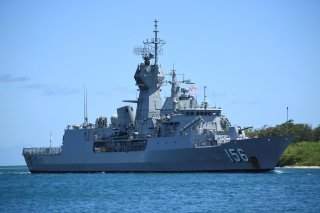Japan and the U.S. Team Up to Sink Ship During RIMPAC Exercise
The ship was no adversary but rather a decommissioned U.S. Navy ship that provided U.S. and allied RIMPAC forces some target practice.
As a part of the United States multinational Rim of the Pacific (RIMPAC) naval exercise, country participants in the exercise fired upon and sank a decommissioned U.S. Navy ship.
A United States Navy statement covering the event explained that “air, land, and sea units from Japan and the U.S. sank the decommissioned Austin-class amphibious transport dock ship ex-USS Denver (LPD 9) in waters more than 15,000 feet deep and over 50 nautical miles North of Kauai.”
The statement added that “with oversight and coordination by the multinational combined task force, the SINKEX enabled partner nations to gain proficiency in tactics, targeting and live firing against a surface target at sea.”
“This sink-at-the-sea exercise demonstrates current operational capabilities and tactical skills, and provides a valuable opportunity to coordinate and collaborate between Japanese Type 12 Surface-to-Ship Missiles (SSM) and the U.S. Army High Mobility Artillery Rocket System (HIMARS) to conduct a live fire and comprehensive exercise,” said Japanese Ground Self-Defense Force (JGSDF) Maj. Gen. Shigeo Kaida, director of the Operations Support & Training Department at the Ground Staff Office in the Japanese Ministry of Defense.
“Alliances with partner nations are a key element to secure our regional stability and enhance our capabilities of deterrence and response in the Indo-Pacific region.”
Though taking out surface ships has typically been the purview of the U.S. Navy, the U.S. Marine Corps is shifting gears and up-gunning to sink large surface ships as the occasion presents itself—and independently of the U.S. Navy.
As a part of Force Design 2030, the Corps is becoming a more decentralized, nimble force and one that can operate independently deep in the Western Pacific.
"The role of Marine Corps aircraft, alongside forces from our partners and allies in this SINKEX, is an awesome display of the versatile combat power the combined force brings to the fight," said U.S. Marine Corps Forces, Pacific Deputy Cdr. Brig. Gen. Joseph R. Clearfield, who serves as the Fleet Marine Force Commanding General and oversees all Marine Corps Forces assigned to RIMPAC.
"It was a bittersweet moment for me, having served aboard USS Denver during my career. But what a way for her to go out! This exercise shows the power of partnerships in the region."
The U.S. Navy explained that prior to sinking, decommissioned ships are thoroughly cleaned and prepared to neutralize any adverse environmental impact they might have. They are also sunk in at least 6,000 feet of water and at least fifty nautical miles from land.
Caleb Larson is a multimedia journalist and defense writer with the National Interest. A graduate of UCLA, he also holds a Master of Public Policy and lives in Berlin. He covers the intersection of conflict, security, and technology, focusing on American foreign policy, European security, and German society for both print and radio. Follow him on Twitter @calebmlarson
Image: Reuters.

